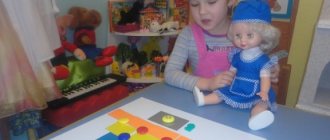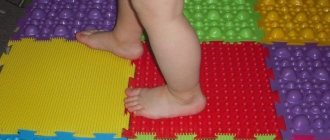Goals of learning to create crafts from waste material in kindergarten, specific tasks and techniques
Waste construction is a productive activity based on creative modeling using a wide range of non-traditional materials to give new life to the world of things that are usually thrown away.
The main goals of designing from waste material are the development of children's creative, intellectual and artistic abilities, as well as environmental education.
By making a variety of crafts (toys, furniture, vehicles), children learn to find unexpected uses for specific waste materials: plastic bottles and plates, containers for Kinder surprises, lids, corks, computer disks, packaging boxes, candy wrappers, polystyrene foam, foam rubber, etc. .
By making a variety of crafts, children learn to find unexpected uses for specific waste materials.
In the process of children constructing crafts from waste materials, teachers strive to achieve the following tasks:
- Three to four years: introduce children to the interesting possibilities of unusual materials (foam rubber, polystyrene foam, plastic bottles, etc.);
- learn to use plasticine, glue, wire, threads, etc. to connect parts and pieces;
- develop fine motor skills.
- develop cognitive and research activities;
- teach children to coordinate their actions in the process of collective work;
By creating original crafts from waste materials, children develop creative thinking.
Techniques for teaching design from waste material are traditionally built on an imitative basis and have their own characteristics at different stages:
- Stage one - detailed analysis of a sample of the future product:
- in the younger group, a craft made in advance by the teacher is used as a model;
- in the middle group, children can be asked to look at a picture or drawn image;
- at the age of six, children are already able to analyze the diagram or model of a toy; the analytical activity of children includes identifying the main parts of the toy and the material from which it is made, discussing clarifying questions, for example: what material for the craft can still be considered;
- what options for fastening parts will be optimal;
- what additional techniques can be used to design details, for example, modeling from plasticine, drawing with felt-tip pens, pencils, paints or applique elements.
- Stage two - children are taught to plan and think about step-by-step progress towards a goal, and are taught a holistic perception of the entire work process. It is specified in what sequence the parts are made, from what material, and which tool will be preferable. The choice of pedagogical techniques is carried out taking into account the age of the children:
- in younger groups, the teacher demonstrates in detail all the stages of constructing a craft, accompanying it with clear and detailed comments;
- in the middle group, the teacher gradually reduces the process of full demonstration and detailed explanation, involving active work with diagrams and supporting plans in the form of schematic sketches drawn by the children themselves.
- Stage three - the method of fastening parts and parts of the structure is thought out:
- in the middle group, plasticine is used as a connecting material;
- older children use glue, thread, wire, etc.
- Stage four provides for children to independently select the necessary material and tools for work.
- Stage five - children independently cope with the entire process of making crafts, from the emergence of a mental prototype of a toy to the substantive embodiment of a creative idea. At this stage, it is important to encourage the manifestation of creative imagination and the child’s desire for independence in the process of practical implementation.
- Stage six - summing up, analysis and evaluation of finished products. It is important to find positive aspects in the work of each child, support and inspire. An excellent technique at this stage would be an exciting role-playing or theatrical game using toys made by children, this will help them feel the significance of their work.
Older preschoolers can independently cope with the process of preparing parts
What to do when you grow up
Construction sets are useful for children.
Sometimes it even affects their future. What to do if you lack design skills after 18? We have collected several tips that have been tested by ourselves, time and Giktayms. Play with children.
This is a pain-free way to try out a bunch of construction kits. By the way, they say that construction is a good prevention of Alzheimer’s disease.
Start a hobby.
Apple engineer Andrew Carroll made a working copy of the Antikythera Mechanism using Lego.
And you can’t say that you wasted your time.
Make a business.
This is an excellent design option with unpredictable results. You can even make your own construction set and sell it.
If you stay in the small business niche, we have come up with a website builder for you.
Design websites.
The good thing about this option is that with the current level of technology development it is suitable for many - knowing HTML is no longer necessary.
Start Arduino.
This method is described on Giktayms on average once a day.
Be nostalgic.
When we did a survey within the company, people recalled how they kept and passed on children’s construction sets, made things out of sticks and ropes, and... how “every thing, after disassembling, turned into a construction set.”
The wonderful influence of Lego on a child's development
In this regard, the story of my friends’ son is very indicative. The boy lagged behind his peers, including in terms of abilities. Even completing assignments in kindergarten was difficult for him. He didn't want to write and draw, sculpt and take tests. Everything caused furious protest!
And then his wise dad bought his son several construction sets. It was both traditional Lego and new, more complex variations on the theme. Dad and son designed together, and they were fascinated by the activity!
After some time, the boy became more diligent and began to show interest in mathematics. He knew very well how to make a model following the instructions. Moreover, I began to come up with my own models! By the first grade, it became clear that he was a smart, quick-witted child with a well-developed imagination.
Construction as a development stimulus for a child
Construction really helps solve some problems and gaps in development. It will also help to discover numerous talents, including developing imagination and creative qualities. The most important condition for this is the game!
Design should not become a duty, a responsibility, a lesson. This game is an ideal activity, interesting and not boring for both children and adults.
It is extremely important that children have access to a wide variety of construction toys. The more there are, the more possible options, the wider the field for imagination. By constructing, a person constantly improves his thought processes, his imagination, fantasy, and creativity.
The benefits of construction for children
Almost all children and almost all adults love to design. It’s just that not everyone admits it! Modern psychologists believe that the love of design is inherent in us as an instinct.
Designers give us, first of all, the development of imagination and creative thinking.
The peculiarity of construction kits is that they usually come with assembly diagrams and instructions. And this, oddly enough, is not always good. But even assembly instructions do not prevent children from developing!
Very soon they get tired of following the schemes, and their imagination and fantasy burst out! Children get creative and come up with their own, sometimes very strange and unusual, objects.
Along the way, they create new things, create, analyze, plan, and act consistently. All this is extremely important for their life as well as their studies.
Influence of designers:
- they provide spatial imagination;
- the ability to understand the properties of geometric shapes;
- help to understand concepts such as shape, size;
- develop imagination, creativity, creativity;
- help to use directions;
- and, finally, they develop independence, perseverance, and hard work - without this, even the most vivid imagination will not result in a worthy result.
Main types of construction sets for children
- Cubes are a real “classic”, a primitive but effective construction set for kids. It introduces shape, color, texture. And it makes it possible to come up with your own models, albeit primitive ones.
- Inserts help to learn how to compare the shapes and sizes of elements, but practically do not develop imagination.
- Mosaic - develops imaginative thinking, because from it you can assemble your own, real picture!
- Block type constructors. You can create anything from these, give free rein to your imagination! You can make houses, airplanes, rockets, whatever!
- Lego is the maximum advantage of a regular construction set, plus the possibility of more complex 3D modeling, consisting of hundreds and thousands of parts. There are practically no limits to the imagination, because here you can make any fantasy come true!
By the way, it is free design (without instructions, tips and diagrams) that opens up the opportunity for children and adults to think outside the box. And also - give free rein to your imagination, fantasize from the heart.
That's all! Develop your imagination and other important skills. And design for your own pleasure, no matter whether you are a child or an adult. Be sure to subscribe to updates on this channel to receive even more important, useful information.
Comments here are also very welcome. If you think this article might be useful to your friends, please share it on social networks. Good luck to you!
Facts and Research
Interesting fact. At the end of the nineteenth century, very realistic construction sets that recreated houses began to be produced in Germany. It was called Anker-Steinbaukasten. These were “stone” blocks made from a mixture of chalk and quartz.
From them you could collect copies of buildings, or come up with your own versions. This is exactly the kind of designer Max Born, Albert Einstein, and Robert Oppenheimer had. And these people cannot be denied a lack of imagination, do you agree?
Numerous studies by scientists confirm that methods and techniques based on construction perfectly develop not only the imagination. This list also includes: fine motor skills, mathematical abilities, independence, speech, logic. And most importantly - interest in creating new things, and creativity!






